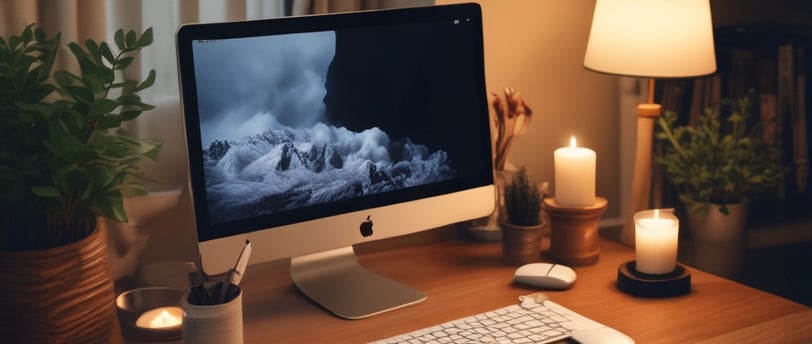How to Build a Cozy and Functional Home Office
2/25/20254 min read


Choosing the Right Furniture
Creating a cozy and functional home office begins with selecting the right furniture pieces that cater to both comfort and practicality. A well-chosen desk serves as the centerpiece of your workspace, influencing your productivity and overall mood. When selecting a desk, consider various styles such as traditional rectangular desks, L-shaped configurations for corner spaces, or standing desks that promote better posture and allow you to alternate between sitting and standing throughout the day. Assess the available space in your office to choose a desk that fits perfectly while ensuring there is enough room to move around freely.
The ergonomic chair is another crucial element in your home office setup. A comfortable chair that provides adequate support can significantly impact your work experience, reducing the risk of discomfort or strain during long hours. Look for chairs designed with adjustable features, allowing you to modify the height, back support, and arm rests to suit your body type. Mesh chairs often offer improved breathability, whereas upholstered options provide a touch of warmth and elegance to your office décor.
In addition to the primary furniture, consider incorporating storage solutions to maintain an organized workspace. Bookshelves and file cabinets not only help keep your materials readily accessible but also complement your office's aesthetic. Open shelving can showcase decorative items and books, while closed cabinets can conceal less visually appealing paperwork. Choosing pieces that harmonize with your chosen color scheme and overall design will enhance the cozy atmosphere of your office, creating a perfect balance between functionality and style.
Lighting Solutions for Productivity
Effective lighting is a pivotal component in establishing a home office that promotes productivity and well-being. The right lighting solutions can play a significant role in reducing eye strain and enhancing overall focus during work hours. One of the most beneficial sources of light is natural daylight, which can significantly improve mood and energy levels. Positioning your desk near a window allows for maximum exposure to daylight, creating an inviting workspace that boosts productivity. When arranging your office, consider the direction of sunlight throughout the day, adjusting your desk’s placement to eliminate glare on screens during peak sunlight hours.
In addition to natural lighting, artificial lighting should not be overlooked. It is essential to select fixtures that provide adequate brightness while minimizing harshness. Overhead lighting can serve as a general illumination source but can often be too intense. Therefore, incorporating task lighting is advisable for focused activities such as reading or writing. Task lamps, particularly those equipped with adjustable arms, enable you to direct light where it’s needed most, reducing the risk of eye strain.
Ambient lighting also contributes significantly to a cozy atmosphere. This type of lighting helps to create a warm and inviting environment, essential for long working hours. Soft, diffused lights, such as floor or table lamps, can be combined with overhead fixtures to layer your lighting scheme effectively. This layered approach allows you to control the level of brightness in your workspace according to the time of day and the task at hand, fostering both functionality and comfort. By thoughtfully designing your lighting solutions, you can achieve an optimal balance that nurtures productivity while ensuring a comfortable and engaging work experience.
Organizational Tools and Techniques
Creating a cozy and functional home office necessitates the implementation of practical organizational tools and techniques. A primary component in achieving an orderly workspace is the use of desk organizers. These are essential for sorting and storing frequently used items such as pens, notepads, and other stationery, ultimately reducing clutter and enhancing efficiency during work hours. By categorizing supplies into designated compartments, desk organizers promote focus by minimizing distractions, allowing for a more productive environment.
In addition to physical organizational items, filing systems play a crucial role in maintaining a tidy home office. Utilizing file cabinets or portable file boxes can keep important documents neatly organized and easily accessible. It is advisable to establish a consistent filing system, using categories like “Urgent,” “Pending,” and “Archived.” This systematic approach not only helps in immediate retrieval but also minimizes the overwhelm that often leads to disorganization.
Whiteboards and corkboards can also serve as effective organizational tools. They offer a visual means to manage tasks, schedule deadlines, and jot down ideas, encouraging employees to remain focused and creatively engaged. By placing a whiteboard in a prominent location, individuals can regularly update their priorities, thus facilitating a clear overview of ongoing projects and responsibilities.
On the digital front, investing in digital organization tools can significantly enhance workflow and time management. Software applications designed for task management, such as Trello or Asana, allow users to create to-do lists and monitor progress, ensuring that important tasks remain in the forefront. Furthermore, employing cloud storage solutions can provide an organized space for important documents, reducing physical clutter while promoting easy access to files from multiple devices.
Lastly, decluttering should be a habitual practice in every home office. Establishing a weekly routine to assess and remove unnecessary items fosters an environment that is not only serene but also functional. By integrating these organizational tools and techniques, one can create a productive home office that maximizes both comfort and efficiency.
Personalizing Your Home Office Space
Personalizing your home office space is essential for creating an environment that you not only find functional but also enjoyable. By incorporating elements that reflect your personality, you can foster a sense of inspiration and creativity that enhances productivity. One of the first steps in this process is to consider decor items that resonate with your interests and aesthetics.
Artwork can serve as a powerful medium of expression in your workspace. Whether it is framed prints, photographs, or original pieces, choosing artwork that brings you joy can significantly impact your mood and motivation. Additionally, consider rotating art pieces from time to time to keep the space fresh. This simple act of changing visuals can stimulate creativity and provide new perspectives.
Integrating plants into your office environment is another excellent way to personalize the space. Not only do plants improve air quality, but they also bring a touch of nature indoors, promoting relaxation and well-being. Opt for easy-to-care-for varieties such as succulents or snake plants, which require minimal maintenance and thrive in various light conditions.
Including personal memorabilia, such as a trophy, travel souvenirs, or family photos, can further enhance the uniqueness of your office space. These items provide a sense of comfort and remind you of achievements, adventures, and loved ones, helping to maintain a balance between professionalism and personal warmth.
As your projects or seasons change, consider refreshing your office decor to align with your current mood or goals. Seasonal decorations or project-specific items can create an ever-evolving workspace. This approach not only maintains aesthetic interest but also allows for continual creativity and adaptability in your home office environment.
